When thunder rumbles in the distance, many dogs exhibit signs of fear and anxiety that can be perplexing to their owners. This common phobia has deep-rooted causes that go beyond mere noise sensitivity.
Understanding the intricate reasons behind why dogs are scared of thunder is essential in providing them with the necessary support and comfort during storms. By unraveling the complexities of this issue, we can shed light on the underlying factors contributing to their distress, paving the way for effective solutions to ease their anxiety and promote their well-being.
Key Takeaways
- Thunder fear in dogs stems from natural timidity, noise phobias, and genetic predispositions.
- Dogs aged 1 to 5 years, certain breeds, and lack of socialization increase susceptibility to thunder fear.
- Symptoms of thunder anxiety include hiding, destructive behavior, and hypervigilance.
- Calming strategies involve avoiding reinforcement of fear, distractions, positive associations, and creating safe spaces.
Causes of Thunder Fear in Dogs
Thunder fear in dogs can stem from a combination of genetic predispositions and environmental factors. Certain dog breeds, inherently timid or nervous, are more prone to developing phobias such as noise phobia and astraphobia.
Up to 50% of dogs experience noise phobia, with reactions to loud sounds serving as protective mechanisms. Factors like age, breed type, and socialization levels can also influence susceptibility to thunder fear. Working dogs, particularly herding breeds and hounds, show a higher prevalence of this fear.
Additionally, genetic components may contribute to fear sensitivity in dogs. Understanding these causes is crucial in addressing and managing thunder fear in our canine companions effectively.
Factors Affecting Susceptibility to Thunder Fear
Contributing to the vulnerability of dogs to thunder fear are various factors such as age, breed predisposition, and socialization levels. These factors can significantly influence how a dog responds to thunderstorms:
- Age: Dogs aged 1 to 5 years are most prone to thunder fear.
- Breed Predisposition: Working dogs like herding breeds and hounds are commonly affected.
- Genetic Components: Genetic factors may play a role in fear sensitivity.
- Socialization Levels: Dogs not well-socialized and those with untreated pain are at risk. Shelter dogs and rescues may be more susceptible to thunder fear.
Symptoms and Management of Dog Thunderstorm Anxiety
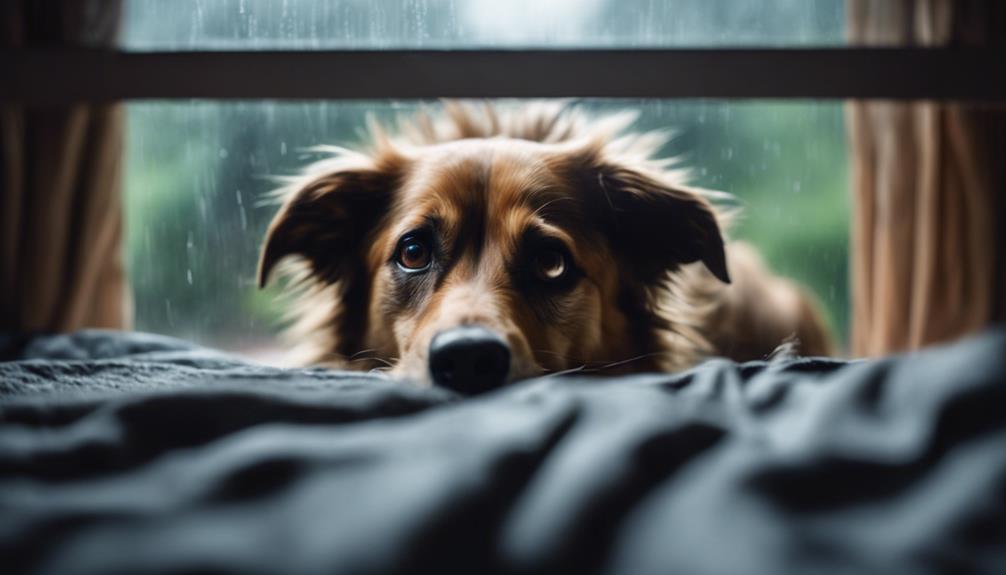
Symptoms of dog thunderstorm anxiety manifest in various behavioral and physical signs that necessitate appropriate management strategies for the well-being of the pet. Common symptoms include hiding, whining, pacing, destructive behavior, attention-seeking, hypervigilance, shaking, and bolting. To effectively manage these symptoms and help calm your dog during a storm, consider the following strategies:
| Behavioral Signs | Physical Signs |
|---|---|
| Hiding | Shaking |
| Whining | Pacing |
| Destructive behavior | Bolting |
| Attention-seeking | Increased heart rate |
| Hypervigilance | Dilated pupils |
Strategies for Calming Dogs During a Storm
To help alleviate your dog's anxiety during a storm, implementing calming strategies can significantly improve their comfort and well-being. Here are some effective strategies to help calm your dog during a storm:
- Avoid displaying anxious behaviors that can trigger your dog's fear.
- Do not overly fuss over your dog during a storm.
- Try to distract your dog or engage them in a different activity.
- Create a positive association with the storm by having a 'thunderstorm party.'
These strategies can help shift your dog's emotional response to the storm and provide them with a sense of security during challenging weather conditions.
Remedies and Techniques for Alleviating Thunder Fear in Dogs
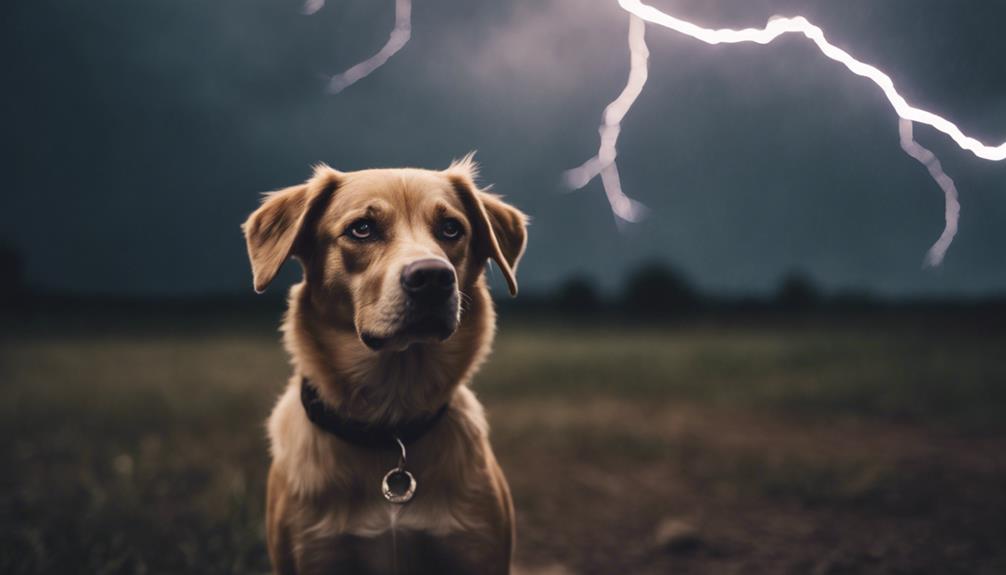
When addressing thunder fear in dogs, implementing various remedies and techniques can aid in alleviating their anxiety and promoting a sense of security during thunderstorms.
Creating a safe den for your dog to hide in can provide a secure environment.
Using white noise machines or calming music to mask thunder sounds can help reduce their stress levels.
Providing distractions such as toys or treats during a storm can divert their attention away from the loud noises.
Consider using calming aids like pressure wraps or pheromone diffusers to help relax your dog.
For more long-term solutions, consulting with an animal behaviorist can provide personalized strategies to address your dog's thunder fear effectively.
Breed Predisposition to Thunder Fear
Certain dog breeds exhibit a predisposition to developing fear and anxiety towards thunderstorms, indicating a potential genetic influence on this specific phobia. These breeds may react more strongly to thunder due to their genetic makeup, making them more susceptible to developing thunderstorm phobia.
Factors contributing to breed predisposition to thunder fear include:
- Heightened sensitivity to sound stimuli
- Behavioral traits passed down through generations
- Specific genetic markers influencing fear response
- Differences in brain chemistry affecting fear processing
Understanding these breed-specific predispositions can help owners and professionals tailor interventions and support for dogs experiencing thunder fear. By recognizing these genetic influences, strategies can be implemented to help alleviate the stress and anxiety these breeds may experience during thunderstorms.
Prevalence of Noise Phobia in Dogs
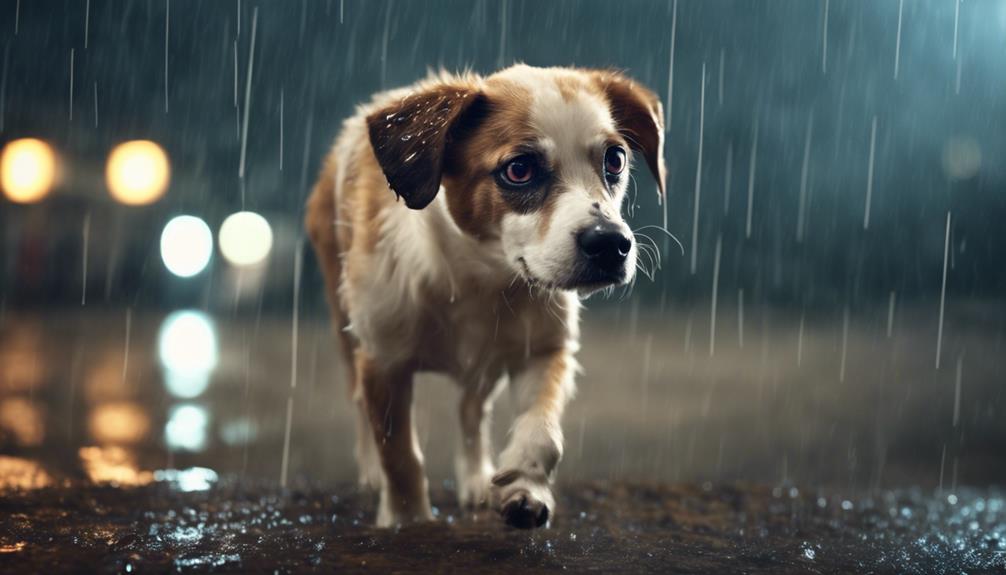
The prevalence of noise phobia among dogs underscores the significant impact loud sounds can have on their well-being and behavior. Research indicates that noise phobia affects up to 50% of dogs, making it a common issue that pet owners may encounter.
Dogs with noise phobia may display various signs of distress such as trembling, pacing, hiding, or vocalizing when exposed to loud noises like thunderstorms, fireworks, or vacuum cleaners. This heightened sensitivity to sound can greatly impact a dog's quality of life and may lead to behavioral problems if not addressed appropriately.
Understanding the prevalence of noise phobia in dogs is crucial for implementing effective strategies to help them cope with their fears and anxieties.
Impact of Genetics on Fear Sensitivity
Genetics play a significant role in determining the sensitivity of dogs to fear-inducing stimuli, such as loud noises like thunderstorms.
- Certain dog breeds inherit a predisposition to fear sensitivity.
- Genetic factors can influence how dogs process and respond to threatening stimuli.
- Dogs with a family history of anxiety disorders may be more prone to thunder fear.
- Understanding the genetic basis of fear sensitivity can help tailor effective management strategies for noise phobia in dogs.
Socialization and Pain as Risk Factors
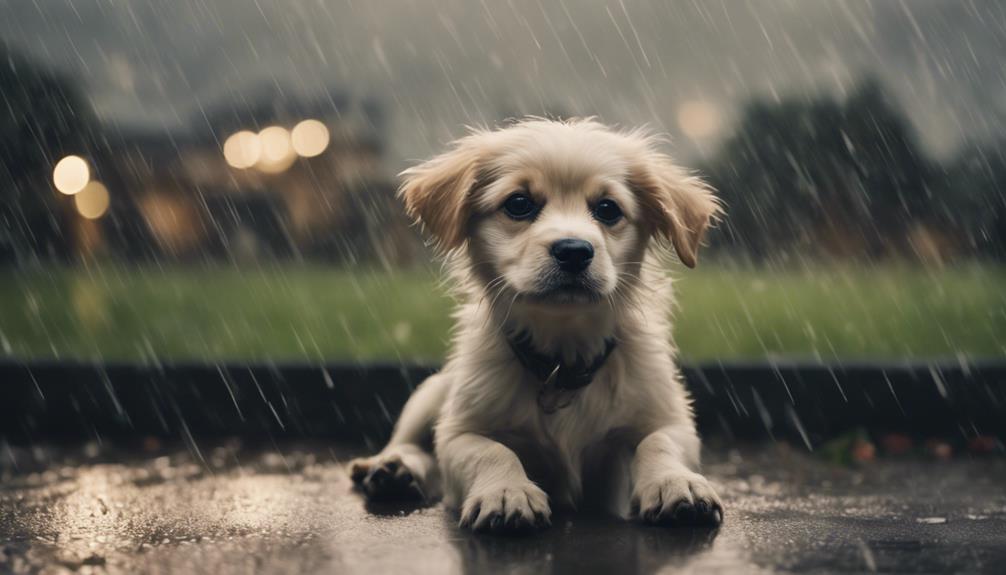
How do socialization and pain contribute to the risk of thunder fear in dogs?
Proper socialization plays a crucial role in a dog's ability to cope with various stimuli, including loud noises like thunder. Dogs that have not been adequately socialized may lack the experiences needed to feel secure during thunderstorms, increasing their likelihood of developing fear.
Additionally, untreated pain can exacerbate a dog's sensitivity to fear-inducing stimuli, such as thunder. Dogs experiencing pain may be more on edge and reactive to loud noises, making them more susceptible to developing a fear of thunder.
Ensuring dogs are well-socialized and addressing any pain promptly can help reduce their risk of developing thunder fear.
Thunder Fear in Working Dog Breeds
Socialization plays a pivotal role in influencing the susceptibility of working dog breeds to thunder fear. Working dogs, such as herding breeds and hounds, are commonly affected due to their specific characteristics and backgrounds. Factors contributing to thunder fear in these breeds include:
- High Sensitivity: Working dogs are often more attuned to their surroundings, making them sensitive to loud noises like thunder.
- Intense Focus: Their strong work ethic and focus may amplify their reactions to sudden and alarming sounds.
- Genetic Predisposition: Certain working breeds may have genetic traits that increase their likelihood of developing noise phobias.
- Training Methods: The training methods employed with working dogs can impact their responses to stressful situations like thunderstorms.
Behavioral Signs of Noise Phobia
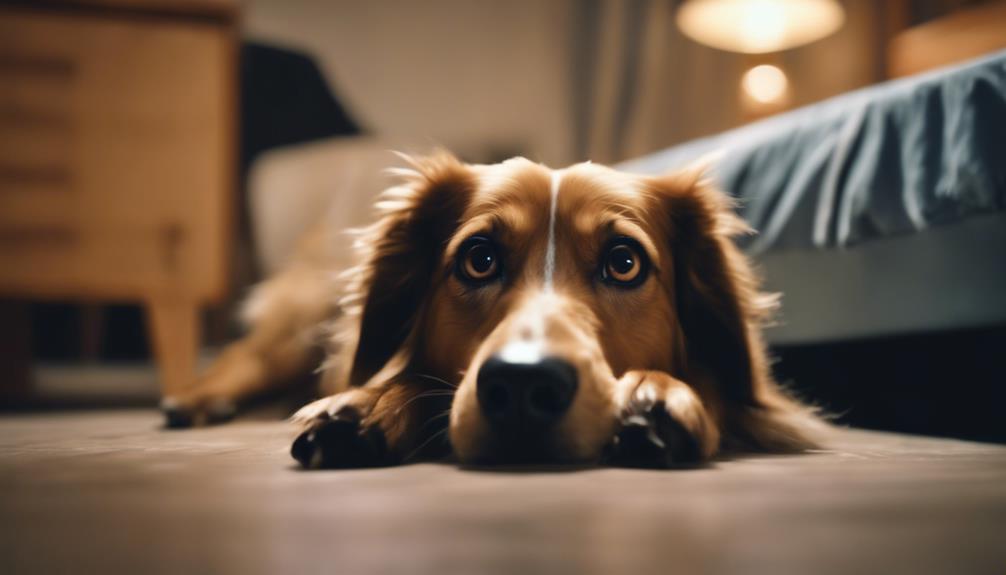
The behavioral signs of noise phobia in dogs encompass a range of observable reactions and responses to loud noises such as thunder. These signs can include trembling, panting, and seeking comfort from their owners. Some dogs may exhibit excessive drooling, barking, or trying to escape the source of the noise. Understanding these behaviors is crucial in effectively managing a noise-phobic dog's anxiety. Below is a table highlighting common behavioral signs of noise phobia in dogs:
| Behavioral Signs | Description |
|---|---|
| Trembling | Shaking or quivering |
| Panting | Rapid breathing |
| Seeking comfort | Clinging to owners |
| Excessive drooling | Dripping saliva |
| Escaping | Trying to run away |
Destructive Behavior in Anxious Dogs
Anxiety in dogs can manifest as destructive behavior, posing challenges for pet owners in managing their pets' well-being. This behavior can range from chewing furniture and shoes to excessive barking and even self-injury. Understanding and addressing this destructive behavior is crucial in ensuring the safety and happiness of anxious dogs.
To effectively manage and reduce destructive behavior in anxious dogs, pet owners can consider the following strategies:
- Provide ample physical and mental stimulation to channel anxiety into positive activities.
- Use calming aids such as pressure wraps or pheromone diffusers to reduce anxiety levels.
- Establish a safe and secure environment for the dog to retreat to during stressful situations.
- Seek guidance from a professional animal behaviorist to develop a tailored behavior modification plan.
Coping Mechanisms for Dogs During Storms
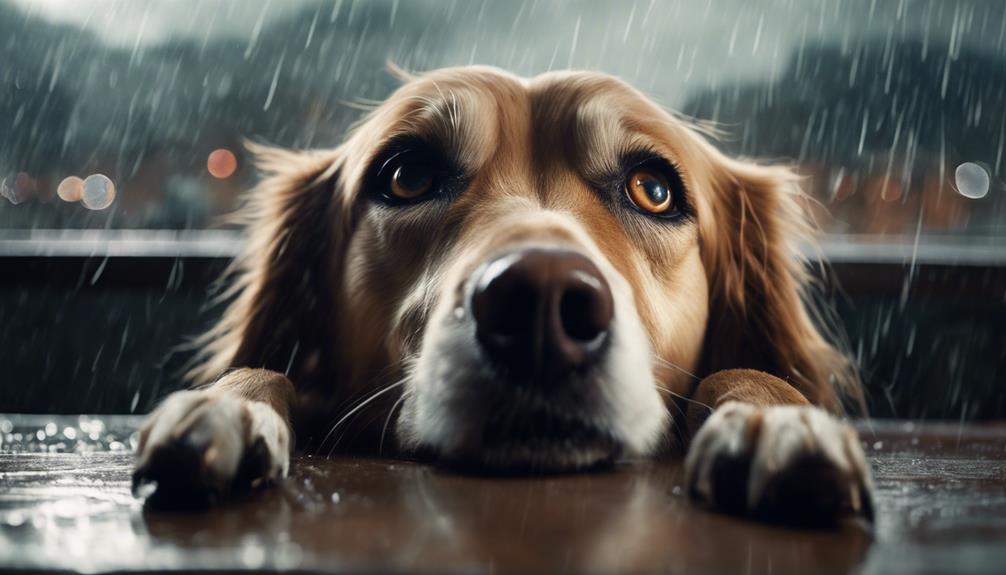
During thunderstorms, dogs can benefit from effective coping mechanisms to help alleviate their fear and anxiety. One approach is to create a safe den where the dog can retreat to feel secure. Using white noise machines or calming music can help mask the sound of thunder and provide a soothing environment.
Providing distractions such as toys or treats can redirect the dog's focus away from the storm. Calming aids like pressure wraps or pheromone diffusers may also help reduce anxiety. It is important not to display anxious behaviors that could trigger the dog's fear further.
Creating Positive Associations With Thunderstorms
To help dogs overcome their fear of thunderstorms, pet owners can implement strategies that focus on creating positive associations with the sound of thunder. One effective way to achieve this is by gradually exposing the dog to recorded thunder sounds at a low volume while engaging in activities your dog enjoys.
Here are some additional techniques to help create positive associations with thunderstorms:
- Use treats or toys to distract and reward your dog during simulated thunderstorm sessions.
- Pair the sound of thunder with calm and relaxing activities such as massage or gentle grooming.
- Provide a safe and comfortable space for your dog to retreat to during storms, equipped with familiar and comforting items.
- Consider incorporating playtime or training sessions during times when there are distant rumblings of thunder to help your dog associate the sound with positive experiences.
Professional Help for Thunder Fear
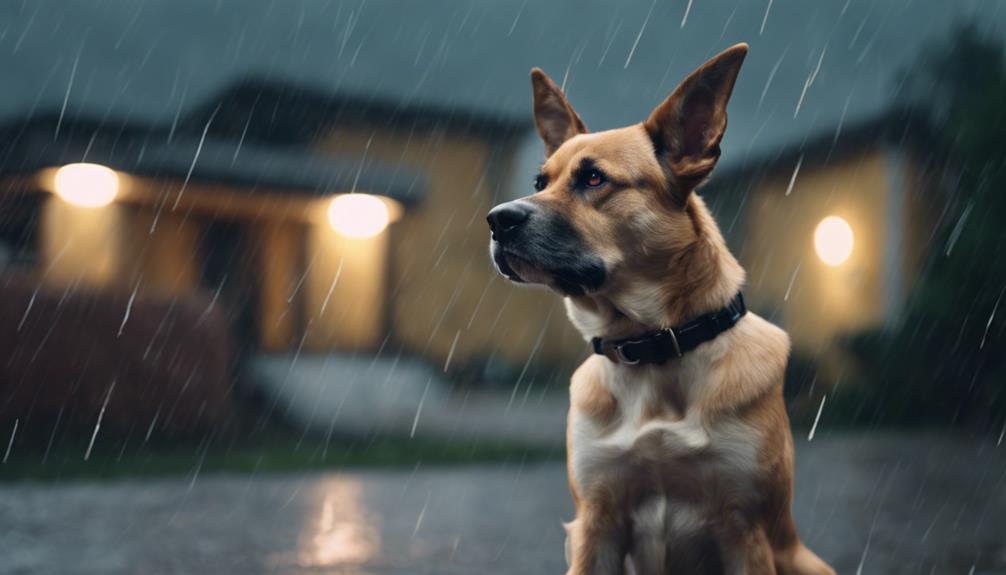
Seeking professional assistance from a certified animal behaviorist can provide tailored strategies and long-term solutions for dogs experiencing thunder fear. These experts can conduct a thorough assessment of your dog's behavior and triggers to develop a personalized treatment plan. Here is a breakdown of the benefits of seeking professional help:
| Benefits of Professional Assistance | Description |
|---|---|
| Personalized Strategies | Tailored techniques to address your dog's specific fears. |
| Behavior Modification | Implementing gradual desensitization and counterconditioning methods. |
| Medication Management | Prescribing anti-anxiety medications if necessary, under veterinary supervision. |
| Ongoing Support | Continuous guidance and adjustments to the treatment plan as needed. |
| Long-Term Solutions | Building resilience and coping mechanisms for future thunderstorms. |
Can the Reasons for a Dog’s Fear of Fireworks Also Apply to Their Fear of Thunder?
Many reasons for a dog’s fear of fireworks can also apply to their fear of thunder. Both can be loud, unexpected noises that trigger anxiety in dogs. Understanding your pup’s fear and seeking professional help can help your pup cope with fireworks and thunderstorms.
Conclusion
In conclusion, the fear of thunder in dogs can be attributed to a combination of genetic predispositions, past experiences, and environmental factors. Understanding the causes and symptoms of thunder fear is crucial in effectively managing a dog's anxiety during storms.
By implementing calming strategies, creating positive associations, and seeking professional help when needed, pet owners can help their dogs cope with thunderstorm anxiety and improve their overall well-being.




